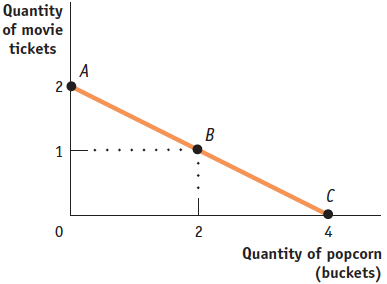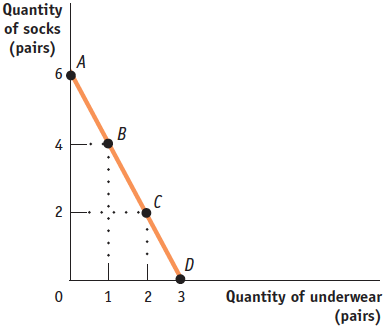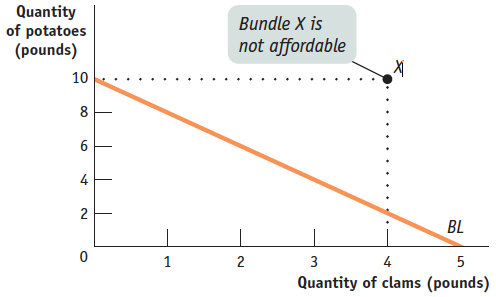Check Your Understanding
Question
Explain why a rational consumer who has diminishing marginal utility for a good would not consume an additional unit when it generates negative marginal utility, even when that unit is free.
Consuming a unit that generates negative marginal utility leaves the consumer with lower total utility than not consuming that unit at all. A rational consumer, a consumer who maximizes utility, would not make such a choice. For example, Figure 51.1 shows that Cassie receives 64 utils if she consumes 8 clams, but if she consumes a ninth clam, she loses a util, decreasing her total utility to only 63 utils. Whenever consuming a unit generates negative marginal utility, the consumer is better off not consuming that unit, even when it is free.Question
In the following two examples, find all the consumption bundles that lie on the consumer’s budget line. Illustrate these consumption possibilities in a diagram, and draw the budget line through them.
The consumption bundle consists of movie tickets and buckets of popcorn. The price of each ticket is $10.00, the price of each bucket of popcorn is $5.00, and the consumer’s income is $20.00. In your diagram, put movie tickets on the vertical axis and buckets of popcorn on the horizontal axis.
The accompanying table shows the consumer’s consumption possibilities, bundles A through C. These consumption possibilities are plotted in the accompanying diagram, along with the consumer's budget line.Consumption bundle Quantity of popcorn (buckets) Quantity of movie tickets A 0 2 B 2 1 C 4 0 
The consumption bundle consists of underwear and socks. The price of each pair of underwear is $4.00, the price of each pair of socks is $2.00, and the consumer’s income is $12.00. In your diagram, put pairs of socks on the vertical axis and pairs of underwear on the horizontal axis.
The accompanying table shows the consumer’s consumption possibilities, A through D. These consumption possibilities are plotted in the accompanying diagram, along with the consumer’s budget line.Consumption bundle Quantity of underwear (pairs) Quantity of socks (pairs) A 0 6 B 1 4 C 2 2 D 3 0 
Question
In Table 51.3 you can see that the marginal utility per dollar spent on clams and the marginal utility per dollar spent on potatoes are equal when Sammy increases his consumption of clams from 3 pounds to 4 pounds and his consumption of potatoes from 9 pounds to 10 pounds. Explain why this is not Sammy’s optimal consumption bundle. Illustrate your answer using a budget line like the one in Figure 51.3.
From Table 51.3, you can see that Sammy’s marginal utility per dollar from increasing his consumption of clams from 3 to 4 pounds and his marginal utility per dollar from increasing his consumption of potatoes from 9 to 10 pounds are the same, 0.75 utils. But a consumption bundle consisting of 4 pounds of clams and 10 pounds of potatoes is not Sammy’s optimal consumption bundle because it is not affordable given his income of $20; a bundle of 4 pounds of clams and 10 pounds of potatoes costs $4 × 4 + $2 × 10 = $36, $16 more than Sammy’s income. This can be illustrated with Sammy’s budget line from Figure 51.3: a bundle of 4 pounds of clams and 10 pounds of potatoes is represented by point X in the accompanying diagram, a point that lies outside Sammy’s budget line. If you look at the horizontal axis of Figure 51.4, it is quite clear that there is no such thing in Sammy’s consumption possibilities as a bundle consisting of 4 pounds of clams and 10 pounds of potatoes.